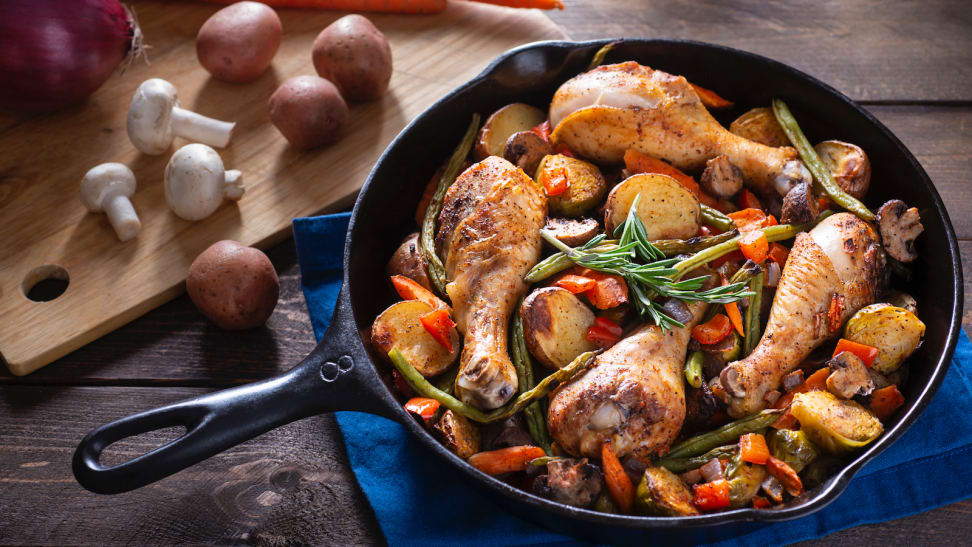 — Recommendations are independently chosen by Reviewed’s editors. Purchases you make through our links may earn us a commission.
— Recommendations are independently chosen by Reviewed’s editors. Purchases you make through our links may earn us a commission.Cast-iron skillets are an American classic. Inexpensively priced and incredibly durable, these pans are prized for developing a natural nonstick coating (called a patina) and valued as family heirlooms. The pans' versatility lets you use them on any type of stovetop, in the oven, on the grill, or even over a campfire.
Because the skillets withstand high heat and hold their temperature, they're great for searing rib eyes, deep-frying chicken, and simmering a chili. And when used for cornbread or macaroni and cheese, these skillets make the crispest, crunchiest crust.
In recent years, a new crop of cast-iron skillets started popping up. These pans are lighter in weight, more polished, designed to be easier to handle, and are exceptionally stick resistant. But most come with a premium price.
Are there big differences? Are the high-priced pans worth the investment? We cooked up a whole lot of food to find out.
After intensive testing, the Lodge Chef Collection 12-Inch (available at Williams-Sonoma) is the best cast-iron skillet that you can buy. It’s great at heating, and its lighter weight makes it easy to handle.
These pans are also available with porcelain enamel finishes inside and out, which makes them easier to clean. In this category, we recommend the Staub Cast-Iron 12-Inch Fry Pan (available at Amazon) as the best you can buy.
These are the best cast-iron skillets we tested ranked, in order:
- Lodge Chef Collection 12-Inch
- Lodge Blacklock 39 12-Inch Triple-Seasoned
- Lodge Classic
- Staub Cast-Iron 12-Inch Fry Pan
- Ayesha Curry Cast-Iron Skillet
- AmazonBasics Pre-Seasoned 12-Inch
- Victoria 12-Inch
- Smithey NO. 12
- Utopia Kitchen Pre-Seasoned Cast-Iron Skillet
- Staub 11-Inch Traditional Skillet
- Finex Cast-Iron Skillet
- Le Creuset Signature Skillet
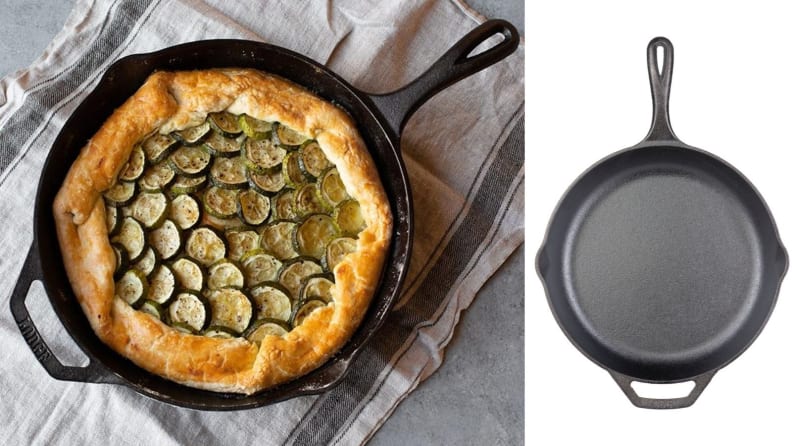

The Lodge Chef Collection 12-inch is the best cast-iron skillet we tested.
Lodge is a family-owned business in Tennessee that has been in operation since 1896. The Chef Collection skillet is a relatively recent introduction. This 12-inch skillet is about two pounds lighter than the traditional Lodge cast-iron pans, and therefore easier to maneuver.
But when it comes to cooking, it’s no slouch. In our tests, cornbread fell right out when the pan was turned upside down, steak cooked with a nice sear, and even scrambled eggs lifted right off the surface. As the Chef skillet isn’t as deep as the original design, it holds in less steam as it browns, giving crustier results.
However, it also leaves less room for oil when you’re making fried chicken. As the skillet is rounded at the edge where the sides meet the bottom, it’s easy to flip pancakes or stir beef and broccoli.
The small rounded handle is designed for comfort and is particularly easy to grasp right where it meets the body to give you good control. On the opposite side, there’s a large helper handle that does just what it’s supposed to do, help, so you get a good grasp when you’re carrying a skillet loaded with peach cobbler to the table.
While Lodge does not offer a set warranty, it claims it stands behind its products and will always solve customers’ complaints to their satisfaction.
You’ll pay a little more than for the classic model, but the Chef skillet is still very affordable and worth the uptick in price.
Pros
-
Affordable
-
Lightweight
-
Comfortable handle
-
Good nonstick properties
Cons
-
No warranty
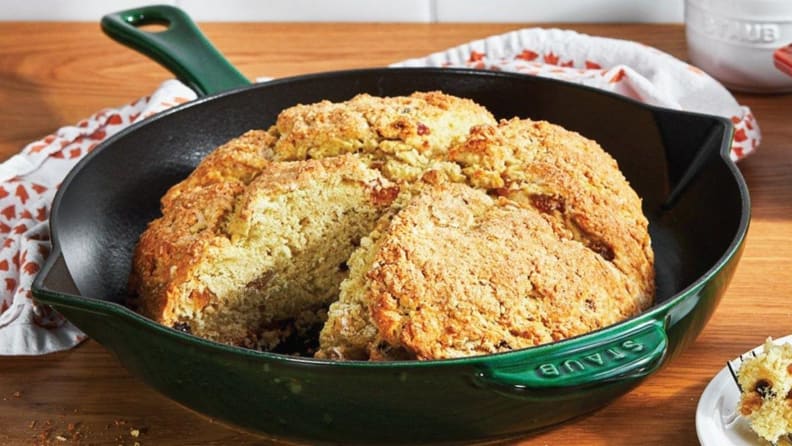

After extensive testing, the Staub Cast Iron 12-inch Fry Pan is our favorite enamel cast-iron skillet.
If you want the heat retention properties of cast-iron without the maintenance, the enameled Staub Cast-Iron 12-Inch Fry Pan is our top choice. This should come as no surprise as Staub's Dutch oven is another Reviewed favorite.
On the exterior of the fry pan, the enamel finish comes in a choice of six shades. The interior has a matte black enamel surface that is somewhat stick resistant but will never substitute for a traditional nonstick coating.
It’s not necessarily easier to scrub either the inside or the outside clean, but you don’t have to worry about rusting and can even toss the Staub in the dishwasher.
This skillet is on the lighter side for cast-iron and has particularly well-defined pour spouts that make it easy to pour out drippings. Made in France, it comes with an astronomical price tag.
Pros
-
Colorful options
-
Great pour spouts
-
Dishwasher safe
-
Lifetime warranty
Cons
-
Expensive
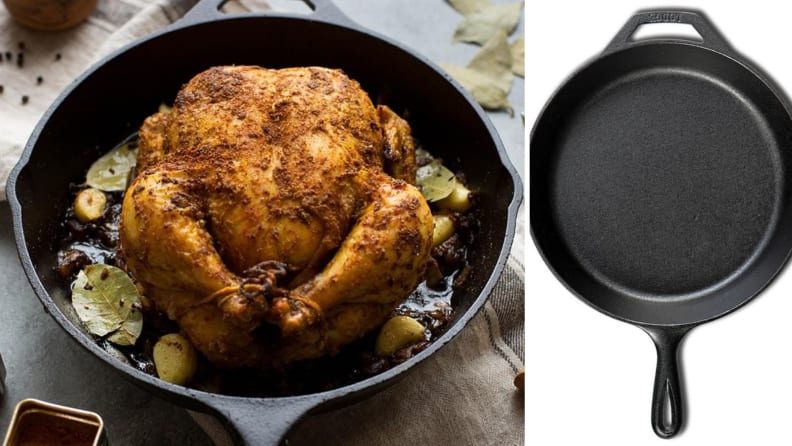

The Lodge Classic Cast Iron Skillet after many years remains one of our top skillets. While there have been improvements in other pans, this remains our best value pick.
Close your eyes and envision a vintage cast-iron skillet and you’ll probably see the Lodge Classic. Like other Lodge skillets, it’s made in South Pittsburg, Tenn. However, it’s more reasonably priced and is widely available.
This Lodge skillet has a wide bottom diameter and it’s deep so it provides lots of room for browning burgers or for frying a big batch of spuds.
Oil won’t bubble over when you add battered chicken pieces to the pan. And the skillet’s pour spouts make it easy to drain all that oil without dribbling. The generously-sized helper handle provides a good grasp even when you’re using a bulky oven mitt or pot holder.
Pros
-
Iconic design
-
Affordable
-
Wide surface
-
Deep
Cons
-
Heavy
How We Tested
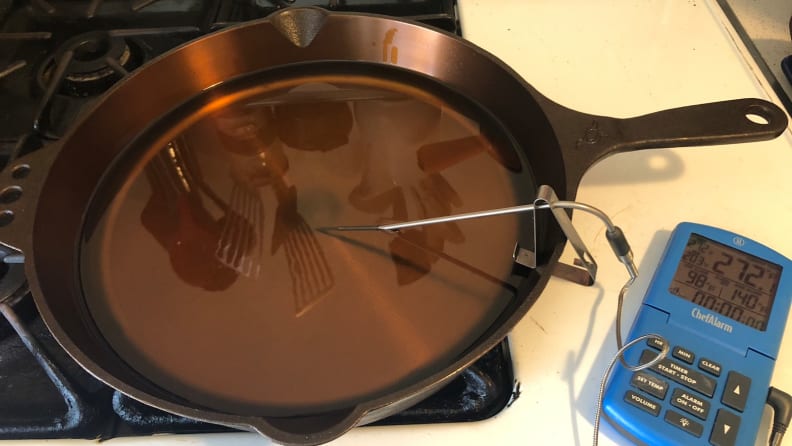
As part of our skillet testing, we heated oil to fry chicken.
The Tester
Hi, I'm Sharon Franke, and I’ve been reviewing kitchen gear for more than three decades. Before that, I worked as a professional chef in New York City restaurants for seven years. But I’ve been cooking at home for even longer and now crank out two meals a day, every day.
In my kitchen, I have cookware made of virtually every material, but the pieces I’m most likely to grab are cast iron. I wouldn’t think of making pork chops in a skillet made of any other material.
Because my pans are well seasoned, they’re also my go-to choice for fried and scrambled eggs; I find them almost as easy to clean as my nonstick omelet pan. And yes, I’ve made more than my share of cornbread in the cast-iron skillet that once belonged to my grandmother.
The Tests
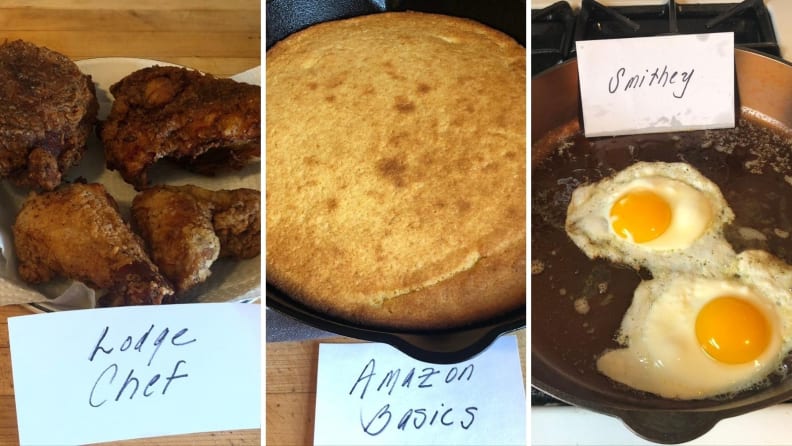
To test cast-iron skillets, we cooked fried chicken, baked cornbread, and fried eggs, looking for even cooking, and to see how easily the food slid out of the pan.
For this review, we tested 12-inch skillets. We believe this is the most versatile size as it’s large enough to hold enough food for a one-dish dinner whether it’s simmered, or fried on the stovetop, or baked in the oven.
Before the food tests, I greased and floured each skillet and heated it to see how evenly it browned across the bottom. My next step was to bake cornbread to check for thorough and even baking, and see how easy it was to flip the bread out of the pan.
Next, I deep fried chickens to help season the skillets. This test revealed differences in how much oil the pans were able to hold and how many chicken pieces they could fry at once.
Then, I seared strip steaks, looking for good browning, and fried eggs over easy to see if they stuck to the pan. I also evaluated whether it was convenient to use a spatula to flip the eggs over. Lastly, I scrambled eggs, noting how much the eggs adhered to the skillet and how much residue they left behind to scrub off.
Each skillet was weighed and measured to determine its heft and how much usable space it offered for cooking food.
As I worked, I considered the overall experience of using each pan: Did it develop a nonstick surface? Did the handles give a good grip and did the spouts make it easy to pour off grease? How easy was it to stash the skillet away and then pull it when it was time to cook?
What You Should Know About Cast-Iron Skillets
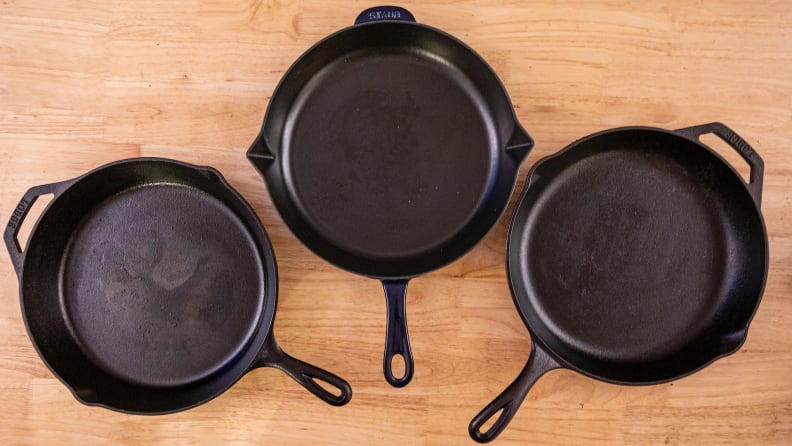
Cast-iron pans are prized for their ability to reach high temperatures and put a great sear on a piece of meat, as well as for their patina, which over time makes these pans almost as slick as pans with nonstick coatings.
But unlike nonstick pans, cast-iron skillets can keep their finish forever. If they do begin to stick, you can re-season them, giving the pans unlimited lifetimes. Considering these pans generally come with a low price tag, cast-iron skillets are incredibly good buys.
Once cast-iron skillets get hot, they stay hot. That means after preheating, there won’t be a drastic drop in temperature when you plop in a sirloin. One thing to keep in mind is that because they get so hot, they can cause smoking. Remember to turn on your exhaust fan when you’re searing in cast iron.
However, these pans don't heat evenly across its entire surface, so you may have to rearrange bacon strips or hamburgers in the pan to get even browning.
Cast-iron skillets are heavy. Even the new generation of lighter pans are several pounds heavier than typical stainless-steel or aluminum pans. Because of their weight, it’s pretty much impossible to toss items like mushrooms or peppers when you sauté them by picking up the pan and shaking it with a flick of your wrist.
And you probably won’t want to use your cast-iron skillet for rolling out an omelet or flipping a crepe. For turning or stirring, you’ll need to use a spoon or spatula but you can go ahead and use metal utensils without worrying about ruining the finish.
As cast-iron skillets are molded in one piece, the handles get very hot and you will always need to use potholders to grasp them.
They also require more careful maintenance than other types of cookware. If you love to throw everything in the dishwasher, cast-iron cookware isn’t for you. It requires hand washing and needs to be dried immediately.
Occasionally, you’ll need to oil and then heat it to keep the surface slick. For storage, we recommend that you find a spot that doesn’t require too much bending or reaching.
Why Should I Buy a Cast-Iron Pan?
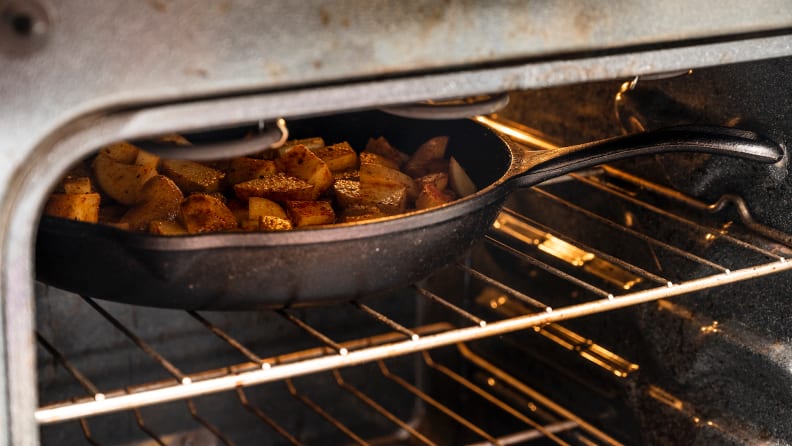
The versatility of cast iron pans means they're great for stovetop or for use in the oven.
A cast-iron skillet is a real workhorse. Heat it up and use it for crusty hamburgers and steaks that rival the ones you turn out on the grill. I know that grill pans are really popular, but trust me, you’ll get results closer to the ones you get when you cook outdoors when you use a cast-iron skillet. A grill pan may provide those attractive grill lines, but a cast-iron skillet better browns the meat, and that’s what gives you that great taste.
Because cast iron excels at holding in heat, it’s also a great choice for frying. Once a layer of oil— whether it's deep or shallow—gets hot, it stays that way, even if you add cold shrimp or frozen mozzarella sticks. It also maintains heat when you’re simmering chicken and peppers or lamb curry so you don’t have to constantly turn the heat up and down.
When using a cast-iron pan in the oven, the bottom of the pan gets hot and then holds in the heat. If you’re the kind of person who prefers the crispy, crunchy corners and edges on baked goods and casseroles, these pans are great for cornbread, brownies, Irish soda bread, macaroni and cheese, and lasagna.
Cast-iron skillets also do a much better job at releasing foods and cleaning up than stainless steel pans. Eggs will release from a well-seasoned cast-iron surface easily and cleaning won’t require much scrubbing. Even when searing chicken breasts, chops, and burgers, less scrubbing to clean the pan is necessary.
How Do I Season a Cast-Iron Skillet?
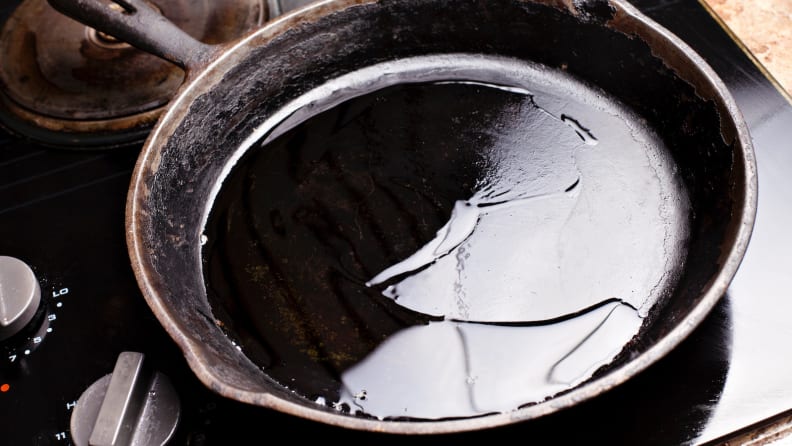
If you season your pan properly, and re-season it when it's needed, your cast-iron skillet should last a lifetime.
While it used to be that you had to season a cast-iron skillet before you even used it, virtually all cast-iron skillets now come pre-seasoned and ready to be used as soon as you get them in your kitchen. Wondering what seasoning is? It’s polymerized oil that’s bonded onto the cast-iron pan, turning it black and forming a surface that’s stick and rust resistant. Each time you cook, the seasoning builds up until your skillet becomes slick and shiny.
If you notice that your skillet is losing its patina or if it develops rust spots, it’s time to re-season the pan.
Start by giving it a good scrubbing. You may need to use steel wool to banish any ust spots. After cleaning and thoroughly drying the skillet, rub a very thin layer of cooking oil into the entire surface, inside and outside.
Place the skillet in the middle of the oven, upside down and position a large baking sheet or piece of aluminum foil on the bottom rack underneath it to catch any drippings. Bake at 450° F for one hour and then allow to cool.
How Do I Clean a Cast-Iron Skillet?
Go ahead and clean your skillet with dishwashing liquid, hot water, and a sponge, gentle brush, or nonabrasive scrubbing pad. Contrary to popular opinion, using soap will not remove the coating that you’ve worked so hard to build up.
After all, if you’ve fried catfish, you certainly want to get rid of any fishy residue before using your skillet to bake an apple crisp. However, using steel wool could remove the seasoning as well as cooking residue so be sure to avoid it during after-dinner cleanup.
Moisture is the arch nemesis of a cast-iron skillet. If you have a lot of stuck-on bits, you can soak your pan briefly but don’t leave it filled with soapy water during dinner or overnight.
After you’ve cleaned the skillet, dry it very thoroughly. It’s a good idea to heat it over low heat for a minute to make sure there’s no droplets lingering on the surface. Occasionally, use a paper towel to rub a very thin layer of oil into the cast iron. And whatever you do, resist the temptation to put your skillet in the dishwasher.
Other Cast-Iron Skillets We Tested
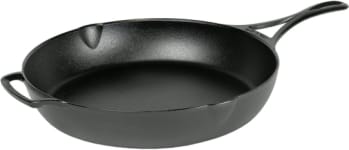
Although the Blacklock 39 is a bit pricier than most Lodge cast-iron pans, it’s less expensive than the new generation of artisanal cast-iron pans or many stainless-steel skillets.
Weighing in at about 6 pounds, it's the lightest of all the skillets we tested, and we found it the most comfortable to work with. Lodge pre-seasoned it with three layers in the factory so it has a smooth finish out of the box and will be that much closer to developing a patina—the natural nonstick coating that forms.
We found it easy to flip over fried eggs and serve a mess of scrambled eggs. At close to 2-inches deep, this skillet easily holds enough oil for deep frying a chicken.
Our only criticism of this high-quality pan is that the rounded and shallow pour spouts make it a little tricky to pour off bacon grease without dribbling.
Pros
-
Triple seasoned
-
Good nonstick properties
-
Lightweight
-
Deep
Cons
-
Pour spout dribbles
-
Pricey
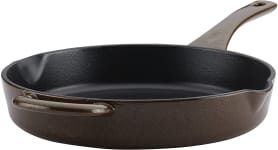
While enameled cast iron looks terrific with its colorful exterior and is easier to care for than unfinished cast iron, it’s generally exorbitantly priced. But not the Ayesha Curry Cast-Iron Skillet—it’s extraordinarily affordable. If you’re looking for an enameled pan, but don’t want to spend a lot of money, this is our top pick.
At about 8 ½ pounds this is one heavy piece of cookware. But it’s also impressively large, and has the widest diameter across the bottom of all the skillets we tested, which means you can brown off more pieces of beef stew meat at once.
At this price your selection of exterior colors is limited to teal, brown, and white. And although this skillet will not require the TLC that cast iron does, the manufacturer advises against using a dishwasher as the rim is untreated cast iron and could rust.
Pros
-
Affordable
-
Colorful options
-
Large cooking surface
Cons
-
Very heavy
-
Not dishwasher safe
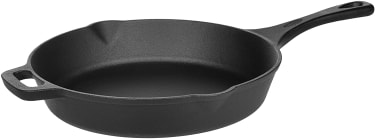
The inexpensive AmazonBasics Pre-Seasoned Cast-Iron Skillet is a real workhorse. It’s the deepest pan we tested and among the widest which means you can load it up with the most food to cook at once. However, at about 8 ½ pounds, it’s also one of the heaviest, giving your arm muscles quite a workout. You definitely don’t want to store it on a bottom or top shelf.
It’s manufactured in China and you’ll notice that although it's pre-seasoned, it has a rough finish. However, that didn’t handicap it when it came to releasing food. Scrambled eggs lifted right off, leaving almost nothing behind to clean up. The handle is longer than on some which means the skillet will have to be placed off center in the oven.
Pros
-
Good nonstick properties
-
Wide bottom
-
Deep
-
Affordable
Cons
-
Very heavy

Like the AmazonBasics, the Victoria skillet is rough around the edges, literally and figuratively. However, it did an excellent job at every cooking task, turning out a well-seared steak, easily holding enough oil to cook a whole chicken, and releasing eggs as if it had a Teflon finish.
It’s a wide and deep pan, which is easy for simmering a one-dish dinner. But it’s long handle makes it a little tricky to place in the oven. Plus, we found the pour spouts are prone to some dribbling.
Pros
-
Good nonstick properties
-
Wide bototm
-
Deep
-
Affordable
Cons
-
Heavy
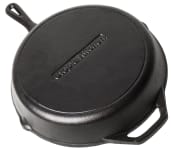
The Utopia Kitchen Pre-Seasoned Cast-Iron Skillet is another basic black skillet that comes from China and is very reasonably priced. After unpacking it, you’ll notice immediately that the finish feels quite rough. Wide and deep, it can easily fry up a whole cut-up chicken at once.
In spite of its coarse surface, the pan developed a slick surface at the end of our testing so that fried eggs slid right out. As its pour spouts are sloped and shallow, they make it difficult to neatly pour out gravy.
Pros
-
Wide surface
-
Deep
-
Good nonstick properties
Cons
-
Very heavy
-
Pour spouts dribble
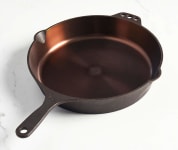
Smithey Ironware is a 5-year-old brand that manufactures its products in the United States. It bills its No. 12 skillet as a “modern heirloom” that’s designed to be a better, more well-thought-out cast-iron product.
The first thing you'll notice is that it looks different. Rather than traditional black, the Smithey No. 12 is a gorgeous bronze shade. As it’s highly polished during the manufacturing process, it has an interior surface that feels incredibly smooth. This distinctive, artisanal skillet will set you back a whopping $200.
Of all the pans in our cook-off, the Smithey is the heftiest, weighing it at over 8 pounds 10 ounces. It offers a good depth for deep frying or cooking a big batch of chili. Unfortunately, in our cooking tests, it didn’t perform as well as skillets costing about an eighth of the price.
Almost immediately we noticed that the finish seemed to wear off, too. Smithey does warn that this will happen and says that over time a black patina, like the ones on traditional nonstick skillets, will build up.
While the smooth surface felt like glass when we scrambled eggs with a wooden spoon, the eggs stuck to the pan and left us with a bigger cleanup job than traditional cast-iron pans. And when we tried to flip out cornbread, it stuck to the pan.
This skillet comes with the best of intentions, but we can’t justify spending the big bucks for a pan that looks a little different out of the box.
Pros
-
Attractive
-
Wide bottom
-
Deep
Cons
-
Very heavy
-
Poor nonstick properties
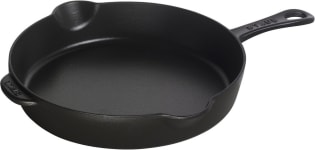
Although the Staub 11-inch Traditional Skillet is produced in France, it has the straight sides that give it the look of a classic American cast-iron skillet.
Inside it has a black matte enamel interior and on the outside, a shiny colorful enamel finish which is dishwasher safe. This Staub weighs just over 6 pounds, so it’s relatively easy to work with. However, that may be in part because it’s an inch smaller than the other skillets we tested. The smaller interior surface also means you won't be able to fry all of your cutlets at once.
This skillet is enameled on the bottom, which made it feel like it was sliding on the burner. This can be scary if it's filled with bubbling oil.
Pros
-
Colorful choices
-
Dishwasher safe
-
Lifetime warranty
Cons
-
Expensive
-
Small cooking surface
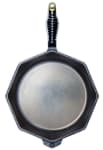
The story of Finex started in Portland, Ore., where its founders set out to reinvent cast-iron cookware as a craft product. Recently, the company was acquired by Lodge and is now manufactured in Tennessee. However, the cookware still has all of the characteristics that make it unique.
The Finex 12-inch Cast-Iron Skillet is octagonally shaped and has a coiled stainless-steel handle. It’s seasoned with flaxseed oil, which gives it a bronze color. It’s highly polished cooking surface is so smooth that it feels like glass under a spatula. The Finex continues to be sold for a premium price.
All of this attention to detail did not produce a better performing skillet. This skillet was less nonstick than the traditional skillets we tested.
To begin with, the first corn bread we baked stuck to the pan. Eggs stuck to the pan, leaving behind gunk to scrub off. By the time our tests were finished, patches of seasoning had been stripped off, exposing the bare metal underneath.
Not only does the handle get hot, but it’s very bulky to grasp. The cooking surface of the pan is the smallest of all we tested so it can accommodate the least amount of food.
While the Finex is nice and deep for frying, it’s not wide enough to cook a whole chicken cut into 8 pieces in one batch. Although the octagonal shape creates a lot of pour spouts around the perimeter, they are prone to dribbles.
Pros
-
Deep
Cons
-
Handle is bulky
-
Poor nonstick properties
-
Expensive
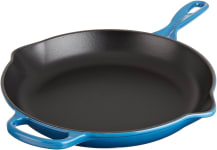
You’ve gotta love the signature design of the aptly named Le Creuset Signature Skillet. This enameled cast-iron model comes in your choice of 16 colors on the outside with matte black enamel on the inside.
It’s a beauty for items like a Dutch baby pancake or a frittata that you want to serve right from the pan at the table. Because of its enamel finishes, you can clean this skillet in the dishwasher, but the cooking surface won’t build up a nonstick patina.
As it’s shallow, the Le Creuset isn’t ideal for deep frying. If you add too much oil, you risk having it bubble over when you add your battered chicken pieces. This French made pan is pricey but comes with the brands great reputation and in its collectable colors.
Pros
-
Colorful choices
-
Dishwasher safe
-
Lifetime warranty
Cons
-
Expensive
-
Shallow

